Build-A-Rig Round 2, SilverStone vs. Crucial: The $800 PC Showdown
by Daniel Williams on November 12, 2015 8:00 AM EST- Posted in
- Build-A-Rig
- Systems
- Crucial
- SilverStone
Gaming Performance
No back-to-school experience would be complete without some (ed: a lot) of gaming, so let’s take a look at the gaming performance of our two systems. One of the interesting aspects about games is that their CPU demands are fairly static – they scale with framerate, but not much else. So even though the performance gap between CPUs and GPUs is much greater at the high-end, with these $800 systems there’s a greater question of whether we’re going to be CPU-limited to begin with since we’re using dual-core CPUs.
We’ll start off our look at gaming performance then with our synthetic 3DMark gaming benchmarks. When working across vendors these benchmarks can be a little more problematic, but since both systems are using GeForce GTX 900 series cards, we should get some reliable results for how the gaming performance of the two systems differs.
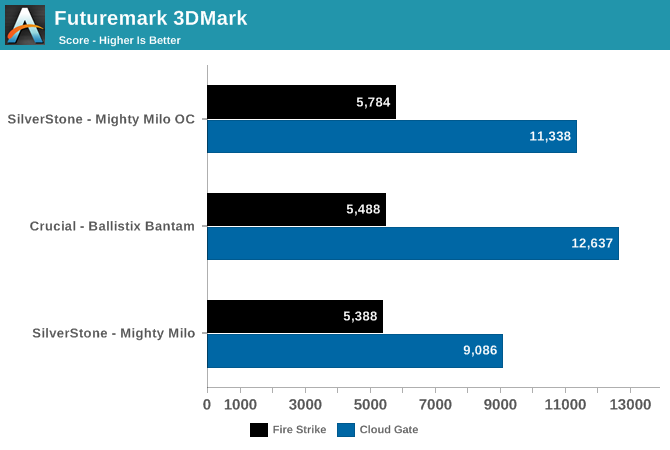
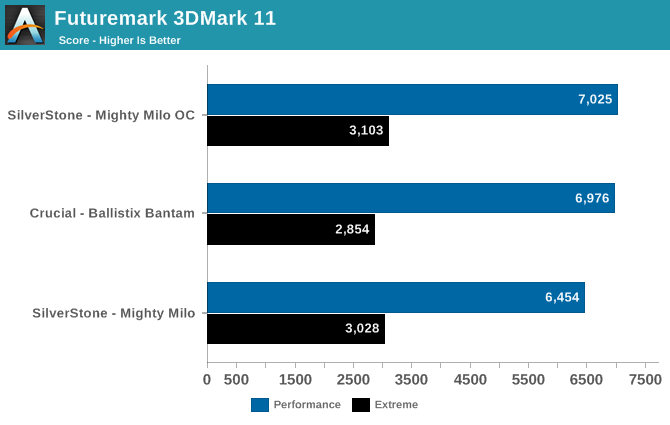
In both 3DMark tests that were ran we actually see our earlier system performance trend continue for a little bit longer. Corsair’s Ballistix Bantam, despite packing a slower GeForce GTX 950 video card, actually edges out the SilverStone build thanks to the performance impact of the CPUs. However once overlcocked, the Mighty Milo can take the lead thanks to a combination of a higher clockspeed and its more powerful video card. Though even then the Corsair build still rules at 3DMark Cloud Gate.
Moving on to our real world gaming benchmarks, we’ll start with The Talos Principle. Croteam’s first person puzzle and exploration game The Talos Principle may not involve much action, but the game’s lush environments still put even fast video cards to good use. Coupled with the use of 4x MSAA at Ultra quality, and even a tranquil puzzle game like Talos can make a good case for more powerful video cards.
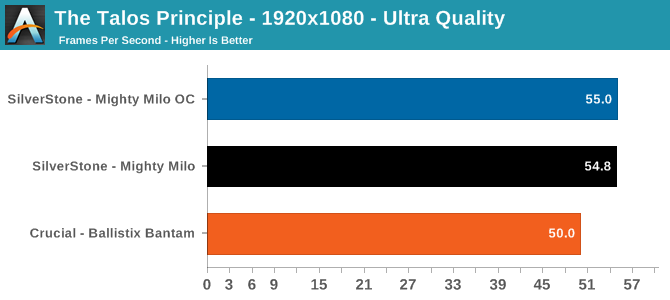
Right off the bat the Mighty Milo takes an easy 10% lead in performance, though it’s good to see that both systems aren’t having any problem staying at a nice and smooth 50+ frames per second. It’s a bit surprising that the difference between the two systems isn’t greater given the video cards, but then again it’s easy to forget that GTX 950 can hold up to GTX 960 rather well at times.
For the racing game in our benchmark suite we have Codemasters’ GRID Autosport. Codemasters continues to set the bar for graphical fidelity in racing games, delivering realistic looking environments layerd with additional graphical effects. Based on their in-house EGO engine, GRID Autosport includes a DirectCompute based advanced lighting system in its highest quality settings, which incurs a significant performance penalty on lower-end cards but does a good job of emulating more realistic lighting within the game world.

Here we actually see very minimal difference between the two machines. Watching CPU usage history while the benchmark was looping I saw CPU utilization lingering up in the 90% and up region, indicating that GRID is solidly CPU-limited in these conditions. This consequently is also why overclocking the Mighty Milo had such an impact, since it directly deals with the immediate bottleneck.
Up next we have Crysis 3. With Crysis 3, Crytek has gone back to trying to kill computers and still holds the “most punishing shooter” title in our benchmark suite.
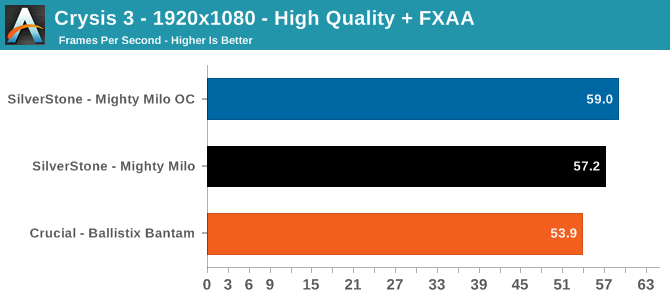
With Crysis 3 the stock SilverStone builds pulls comfortably ahead with a lead of 7%, thanks to its more powerful video card. Overclocking the Pentium G3258 has a minor impact here, netting us a couple more frames per second and almost squeaking out a 60fps average. What's worth bringing up from my notes though is there was pretty much no difference in minimum fps on the Mighty Milo. So while scores are higher here it may not feel that different when performance is really needed.
The open world action game in our benchmark suite is Grand Theft Auto V. The latest edition of Rockstar’s venerable series of open world games, Grand Theft Auto V was originally released to the last-gen consoles back in 2013. However thanks to a rather significant facelift for the current-gen consoles and PCs, along with the ability to greatly turn up rendering distances and add other features like MSAA and more realistic shadows, the end result is a game that is still among the most stressful of our benchmarks when all of its features are turned up.
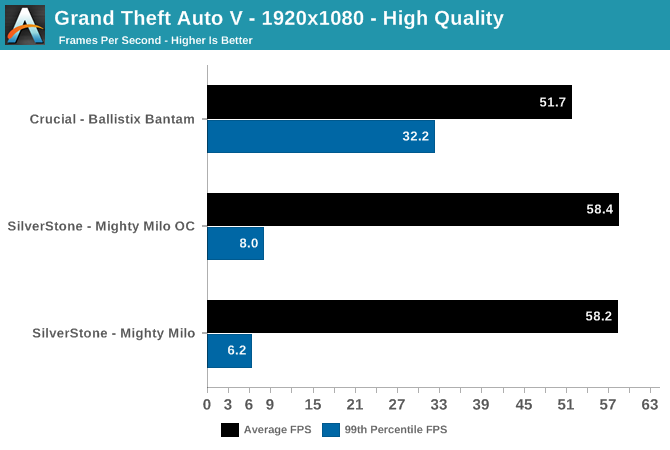
Both of our builds here today put out admirable averages under GTAV, each averaging over 50fps. However the 99th percentile frame times tell us a different story. Here the Mighty Milo struggles worse than usual here and stalls every couple of seconds. With the minimum CPU requirement for this game being a quad-core processor and seeing the GPU load running very erratically it would appear that even with an overclock the Pentium G3258 struggles to provide a consistent experience. Despite its lower average framerate the Ballistix Bantam does a much more admirable job of maintaining a smooth playing experience.
Our final gaming benchmark is the latest iteration of Valve’s massively popular MOBA, Dota 2 Reborn. The Reborn edition marks the move to the Source 2 engine, and has significantly altered the playing field as far as performance goes, with Valve stating that the new engine is even more scalable to low-end hardware than the already low-end friendly Source 1 version of Dota 2.
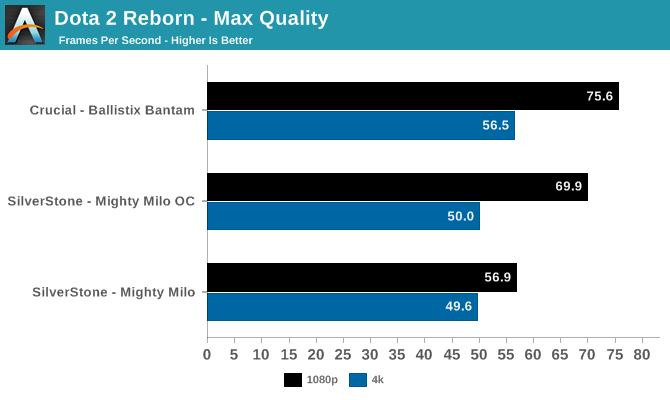
Here I encountered a few surprises with our new Dota 2 benchmark. When I first started testing I used 1080p at maximum quality, and then followed-up with 4K at the same quality settings to see how performance scaled with resolution. To my surprise, both of these systems, especially at 1080p, are CPU limited. So much so in fact that we see much smaller framerate drops than we are used to when kicking the game into 4K. In fact this game appears to be so CPU limited that the Pentium running in the Mighty Milo drags the NVIDIA GTX 960 to below what the Core i3-4170 can do with the NVIDIA GTX 950. This is a great example of how even games aren't exclusively a GPU benchmark.
Finally, while looking at gaming performance we’re also taking a look at GPU compute performance via CompuBench 1.5. Backed by OpenCL, we’ve picked out three of the benchmark’s suites best sub-tests, highlighting different use cases for GPU compute in modern systems.
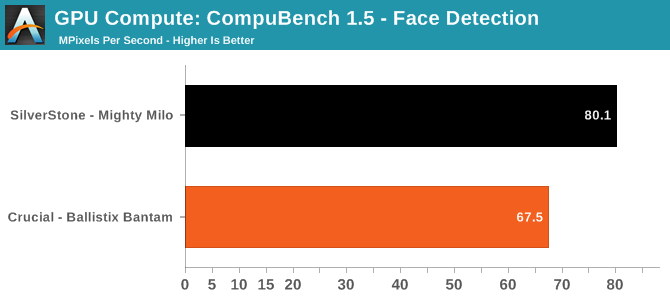
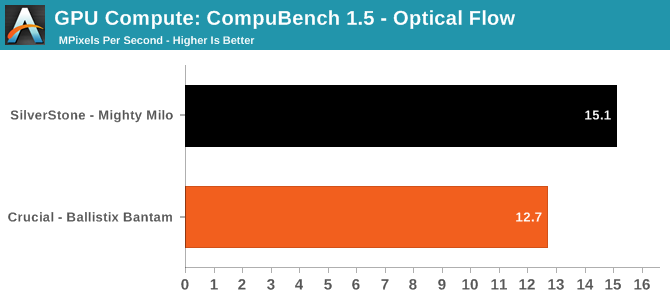

In compute we see that the GTX 960 found inside SilverStone’s Mighty Milo practically trounces the GTX 950 we see in Crucial's Ballistix Bantam. For any workloads that can lean on GPU compute such as video editing, scientific computing, or anything that touches 3D modeling, the GTX 960 will help make for a more effective machine. Assuming of course that some complementary CPU grunt isn't entirely necessary.










43 Comments
View All Comments
Shadowmaster625 - Thursday, November 12, 2015 - link
So in other words, use the Milo build, but replace the cpu and gpu with the i3 and the 950, since the pentium and the 960 dont have enough threads to make proper use of the added gpu power.dsraa - Thursday, November 12, 2015 - link
finally, a DIY project that a regular person can afford!! I'm sick of those 'dream' systems that no-one buys, or has the money to even think about.nguyendot1 - Friday, November 13, 2015 - link
Does that ASROCK board have the latest bios? I have the latest on mine and the non-z overclocking is now disabled.Daniel Williams - Saturday, November 14, 2015 - link
No the ASROCK motherboard does not have the latest BIOS. Luckily for my schedule it had overclocking enabled out of the box.Unfortunately I do not know off hand how far back one has to go to regain overclocking, though I was warned that it may be necessary.
nguyendot1 - Tuesday, November 17, 2015 - link
So I had to downgrade from the latest bios to the last one (august?) and it brought back overclocking. Unfortunately it also bricked my motherboard for a few hours until I could tear the mini-itx case apart (Lian Li Q25) and hit the reset CMOS jumper. After multiple lacerations from the tight clearance I was able to reset it and force it to F6 - quick bios flash from a USB drive. Yay 4.4ghz is back.isaac12345 - Monday, November 16, 2015 - link
Both the builds are unnecessarily stiffled. Just take the first one's case, the Milo, and put the second build's components except for the gfx card and psu. Retain those components and I'm pretty sure the winner will be far happier. Overclocking reduces reliability and increases heat. The winner should not be expected to fiddle to OC the system.Or simply take out the SSD in the first one and spread the money across a better CPU and a motherboard with better wifi. 120GB is hardly anything after formatting, installing the OS, apps and games.
isaac12345 - Monday, November 16, 2015 - link
Not to forget, get the 7200rpm version of the HDD. The build will be a lot more futureproof.ayejay_nz - Wednesday, November 18, 2015 - link
Cool series!I thought the i3 would help a lot more than it did ^^ It seems the 960 had a bigger impact :o
tipoo - Monday, November 23, 2015 - link
Keep in mind that's only an average - Techreport and Digital Foundry frame time testing show the i3 is a big upgrade from the Pentium for frame time averages. Two extra threads help a lot.erotomania - Friday, November 20, 2015 - link
Crucial may not appreciate being called Corsair (right after 3DMark graphs I believe)